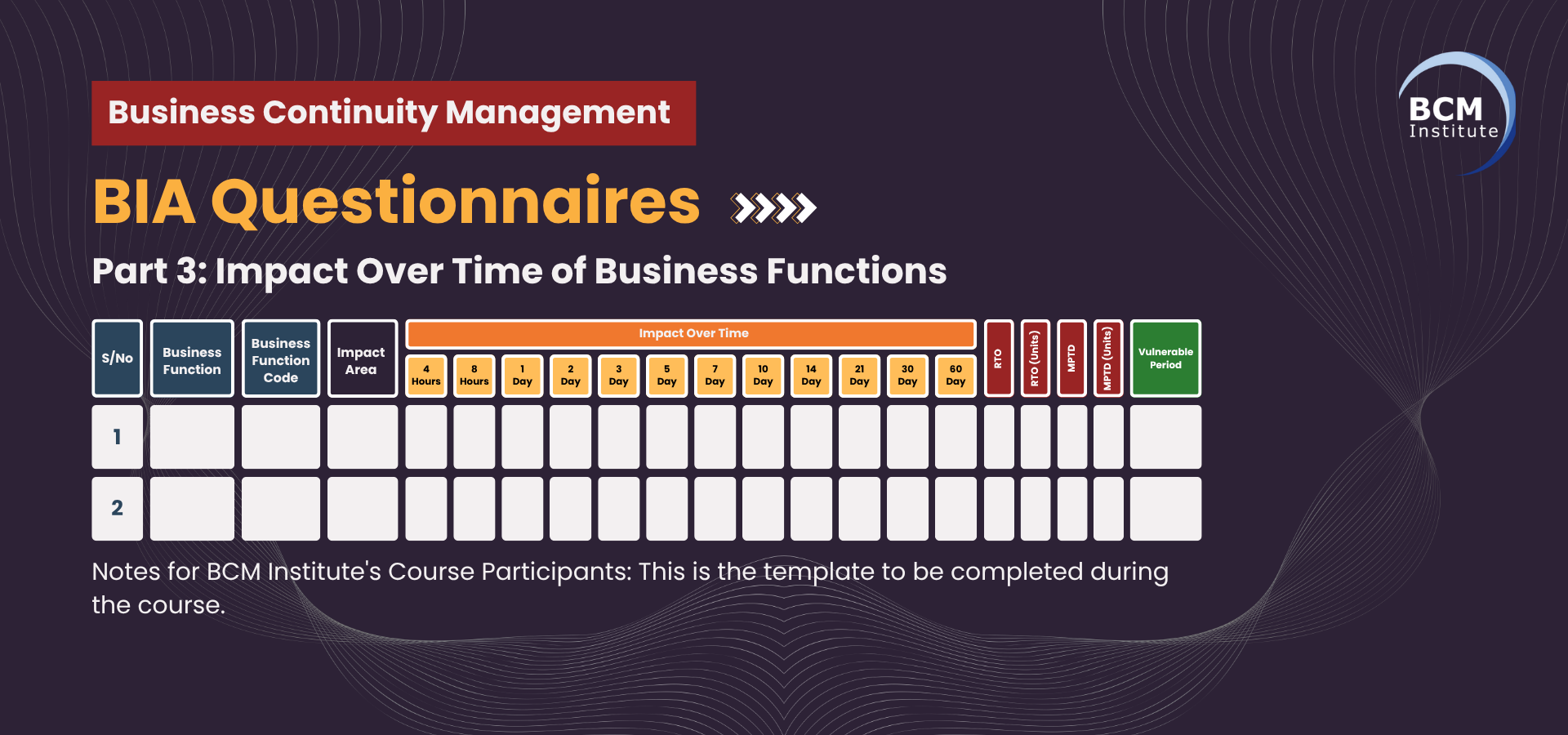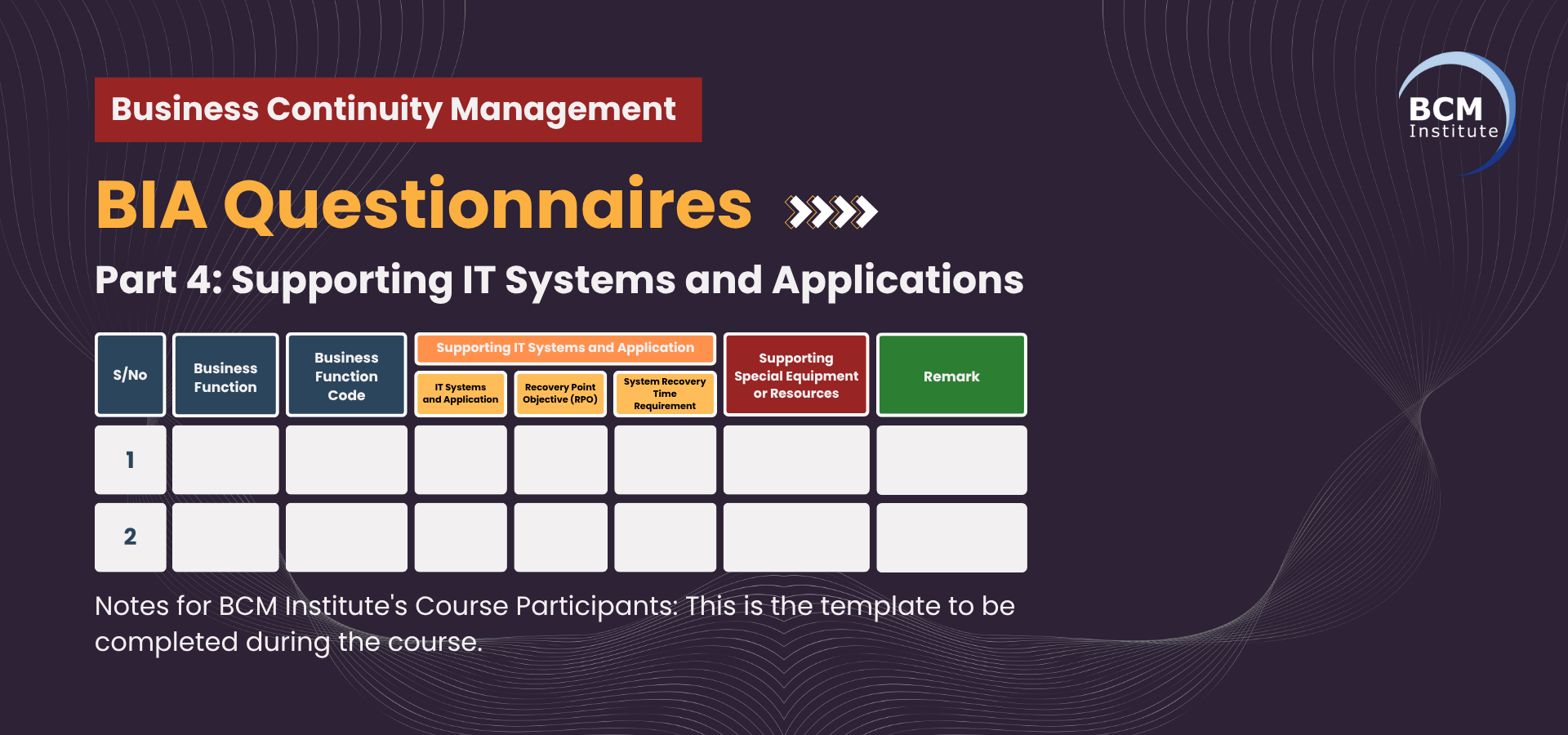[Business Impact Analysis] [Critical Business Function] [T2] Part 3

Part 3: Impact Over Time of Business Functions
CBF-1: Labour Market Regulation and Enforcement
![[BCM] [MOM] [E3] [BIA] [T2] [CBF] [1] Labour Market Regulation and Enforcement](https://no-cache.hubspot.com/cta/default/3893111/bcb5337e-1bdd-47dc-b0af-399dfc78021a.png)
The Ministry of Manpower’s Critical Business Function (CBF-1) Labour Market Regulation and Enforcement is crucial to safeguarding Singapore’s labour standards, ensuring fair employment practices, maintaining workplace safety, and promoting overall workforce well-being.
To ensure the continued protection of workers and the smooth functioning of the labour market, it is vital to assess how disruptions to these business processes or sub-business functions (Sub-CBFs) affect operations over time.
This section evaluates the impact trajectory of each Sub-CBF across defined time intervals, ranging from 4 hours to 60 days, to determine both the Recovery Time Objective (RTO) and the Maximum Tolerable Period of Disruption (MTPD).
The scoring scale (1 to 5) is used to reflect the severity of disruption, where 1 denotes minimal impact and 5 represents severe impact with significant consequences on manpower regulation, compliance, and stakeholder trust.
This structured analysis enables MOM to prioritise recovery, allocate resources effectively, and minimise vulnerabilities during periods of operational disruption.
Table 3: Impact Over Time of Business Functions of Sub-CBFs for CBF-1
|
Sub-CBF Code |
Sub-CBF |
Highest-Impact Area |
4H |
8H |
1D |
2D |
3D |
5D |
7D |
10D |
14D |
21D |
30D |
60D |
RTO |
MTPD |
Vulnerable Period |
|
1.1 |
Policy & Regulation Design |
National Labour Policy Integrity |
1 |
1 |
2 |
2 |
3 |
3 |
3 |
4 |
4 |
4 |
5 |
5 |
14 days |
60 days |
Policy review cycles, parliamentary sessions |
|
1.2 |
Licensing & Permits |
Employer/Worker Compliance & Legitimacy |
2 |
3 |
3 |
4 |
4 |
5 |
5 |
5 |
5 |
5 |
5 |
5 |
3 days |
14 days |
Peak hiring seasons, foreign worker intake periods |
|
1.3 |
Inspections, Monitoring & Investigation |
Workplace Safety & Employment Standards |
2 |
3 |
4 |
4 |
4 |
5 |
5 |
5 |
5 |
5 |
5 |
5 |
2 days |
7 days |
High-risk sector incidents (construction, marine, etc.) |
|
1.4 |
Adjudication & Dispute Resolution |
Industrial Harmony & Employer-Employee Relations |
2 |
2 |
3 |
3 |
4 |
4 |
4 |
5 |
5 |
5 |
5 |
5 |
5 days |
21 days |
During major wage or retrenchment disputes |
|
1.5 |
Enforcement Actions & Sanctions |
Compliance Credibility & Deterrence |
3 |
3 |
4 |
4 |
5 |
5 |
5 |
5 |
5 |
5 |
5 |
5 |
2 days |
7 days |
Following high-profile violations or accidents |
|
1.6 |
Stakeholder Engagement & Education |
Public Confidence & Workforce Preparedness |
1 |
2 |
2 |
3 |
3 |
3 |
4 |
4 |
4 |
5 |
5 |
5 |
7 days |
30 days |
Labour market campaigns, awareness weeks |
|
1.7 |
Regulatory Intelligence & Risk Management |
Strategic Labour Market Stability |
1 |
2 |
2 |
3 |
3 |
4 |
4 |
4 |
5 |
5 |
5 |
5 |
10 days |
30 days |
During emerging threats (economic downturn, pandemic) |
Summing Up … for Part 3
The impact assessment for CBF-1 Labour Market Regulation and Enforcement highlights the time sensitivity of different Sub-CBFs. Activities such as enforcement actions, inspections, and licensing require rapid recovery within 2–3 days to maintain compliance and protect worker safety.
Meanwhile, functions like policy design and stakeholder engagement demonstrate a longer tolerance period but still carry significant long-term implications if disruptions persist.
By mapping these impacts over time, MOM gains a clear picture of the Recovery Time Objectives (RTOs) and Maximum Tolerable Periods of Disruption (MTPDs) for each Sub-CBF.
This analysis ensures that resources can be directed to time-critical functions first, thereby sustaining labour market confidence, compliance integrity, and the well-being of Singapore’s workforce.
[Business Impact Analysis] [Critical Business Function] [T2] Part 3

Part 4: Supporting IT Systems and Applications
CBF-1: Labour Market Regulation and Enforcement
![[BCM] [MOM] [E3] [BIA] [T2] [CBF] [1] Labour Market Regulation and Enforcement](https://no-cache.hubspot.com/cta/default/3893111/bcb5337e-1bdd-47dc-b0af-399dfc78021a.png)
The effective regulation and enforcement of Singapore’s labour market relies heavily on robust digital systems and applications that underpin the Ministry of Manpower’s (MOM) core operations.
These IT systems facilitate regulatory design, licensing, inspections, adjudication, enforcement, stakeholder engagement, and intelligence gathering.
Ensuring their resilience, security, and recoverability is crucial to maintaining MOM’s ability to safeguard fair employment practices, protect workers’ rights, and uphold national labour standards.
This section details the supporting IT systems and applications mapped against each Sub-Critical Business Function (Sub-CBF) under CBF-1 Labour Market Regulation and Enforcement, together with their Recovery Point Objectives (RPO), System Recovery Time Objectives (RTO), and dependencies on specialised resources.
The analysis highlights the technology backbone that enables MOM to sustain business continuity and regulatory effectiveness, even in times of disruption.
Table 4: Supporting IT Systems and Applications of Sub-CBFs for CBF-1
|
Sub-CBF Code |
Sub-CBF |
IT Systems and Applications |
RPO |
System RTO |
Supporting Special Equipment or Resources |
Remarks |
|
1.1 |
Policy & Regulation Design |
MOM Policy Management System, Legislative Drafting Tools, Secure Document Repositories |
24 hrs |
48 hrs |
Secure servers, collaboration platforms |
Critical for formulating labour policies; relies on secure data storage. |
|
1.2 |
Licensing & Permits |
Work Permit Online (WPOL), Employment Pass Online (EPOL), COMPASS System |
4 hrs |
8 hrs |
Smart card authentication, secure payment gateways |
High dependency on online access; continuity ensures smooth labour mobility. |
|
1.3 |
Inspections, Monitoring & Investigation |
Inspection Management System (IMS), Case Management System (CMS), Mobile Inspection Devices |
4 hrs |
8 hrs |
Tablets with secure apps, mobile connectivity kits |
Mobile access crucial for field officers; fast recovery is essential. |
|
1.4 |
Adjudication & Dispute Resolution |
Dispute Resolution Case System (DRCS), eLitigation Portals, Mediation Scheduling Tools |
8 hrs |
24 hrs |
Video conferencing systems, secure evidence storage |
Supports Fair Employment Practices Tribunal and mediation services. |
|
1.5 |
Enforcement Actions & Sanctions |
Enforcement Case Tracking System, Prosecution Management Platform |
8 hrs |
24 hrs |
Digital evidence management devices |
Ensures compliance with labour laws; sensitive case data requires high security. |
|
1.6 |
Stakeholder Engagement & Education |
MOM Corporate Website, Outreach & E-Learning Platforms, Public Feedback Portals |
12 hrs |
24 hrs |
Web hosting servers, social media integration |
Continuity ensures trust and transparency with the public and employers. |
|
1.7 |
Regulatory Intelligence & Risk Management |
Labour Market Analytics System, Risk Assessment Tools, Data Warehousing & Analytics |
12 hrs |
24 hrs |
High-performance computing, secure data feeds |
Supports proactive policy and risk-based enforcement. |
Legend (Impact Scale)
- 1 – Negligible
- 2 – Minor
- 3 – Moderate
- 4 – Significant
- 5 – Critical
Summing Up … for Part 4
The Ministry of Manpower’s ability to enforce labour laws and regulate the workforce effectively depends not only on operational processes but also on the resilience of its supporting IT infrastructure.
The systems outlined above form the digital backbone of regulatory functions, ranging from licensing to enforcement and intelligence.
Establishing clear Recovery Point Objectives (RPOs) and Recovery Time Objectives (RTOs) for these systems ensures that MOM can minimise data loss, reduce downtime, and maintain public confidence during disruptions.
Moreover, identifying special equipment and resources enhances MOM’s readiness to sustain critical labour market regulatory functions under adverse scenarios.
In summary, business continuity for CBF-1 hinges on safeguarding IT systems and applications, making them indispensable to MOM’s mission of shaping a fair, safe, and progressive workplace environment for all.
More Information About Business Continuity Management Courses
To learn more about the course and schedule, click the buttons below for the BCM-300 Business Continuity Management Implementer [BCM-3] and the BCM-5000 Business Continuity Management Expert Implementer [BCM-5].





![[BCM] [MOM] [E3] [BIA] MBCO Corporate MBCO](https://no-cache.hubspot.com/cta/default/3893111/91c07ac1-2f4d-4acf-a002-df50ac7e8f19.png)
![[BCM] [MOM] [E3] [BIA] [P&S] Key Product and Services](https://no-cache.hubspot.com/cta/default/3893111/904a4659-6e74-4f50-a27d-b0543463d80a.png)
![[BCM] [MOM] [E3] [RAR] [T1] List of Threats](https://no-cache.hubspot.com/cta/default/3893111/41c8981e-45dd-416c-90e0-55c3a22753da.png)
![[BCM] [MOM] [E3] [RAR] [T2] Treatment and Control](https://no-cache.hubspot.com/cta/default/3893111/02909b01-2511-4249-864b-967afcc727bc.png)
![[BCM] [MOM] [E3] [RAR] [T3] Risk Impact and Likelihood Assessmen](https://no-cache.hubspot.com/cta/default/3893111/fd3dd074-a74d-45ec-8219-3cee4c0463c4.png)
![[BCM] [MOM] [E3] [BCS] [T1] Mitigation Strategies and Justification](https://no-cache.hubspot.com/cta/default/3893111/06674b8b-3cf9-4855-a89a-ecd2baa9a395.png)
![[BCM] [MOM] [E1] [C10] Identifying Critical Business Functions](https://no-cache.hubspot.com/cta/default/3893111/f19dbb07-448c-4021-9605-82ad98643d7f.png)
![[BCM] [MOM] [E3] [BIA] [DP] [CBF] [1] Labour Market Regulation and Enforcement](https://no-cache.hubspot.com/cta/default/3893111/ff0a9479-fa3e-41a8-ba7b-9d151a715d05.png)
![[BCM] [MOM] [E3] [BIA] [T1] [CBF] [1] Labour Market Regulation and Enforcement](https://no-cache.hubspot.com/cta/default/3893111/6eaa5c4f-0bd6-4343-85a8-d94449364aa5.png)
![[BCM] [MOM] [E3] [BIA] [T3] [CBF] [1] Labour Market Regulation and Enforcement](https://no-cache.hubspot.com/cta/default/3893111/bbc0c267-3d28-497d-9504-5d1853058e7b.png)
![[BCM] [MOM] [E3] [BCS] [T2] [CBF] [1] Recovery Strategies](https://no-cache.hubspot.com/cta/default/3893111/c295a198-de84-41b2-be64-0a5d39bf87fe.png)
![[BCM] [MOM] [E3] [BCS] [T3] [CBF] [1] Minimum Resources Required during a Disaster](https://no-cache.hubspot.com/cta/default/3893111/68673062-6e5b-4e51-9226-4da013aaaa0e.png)
![[BCM] [MOM] [E3] [PD] [CBF] [1] Labour Market Regulation and Enforcement](https://no-cache.hubspot.com/cta/default/3893111/2ef54310-5f33-42cd-874b-187f278267ee.png)


![Register [BL-B-3]*](https://no-cache.hubspot.com/cta/default/3893111/ac6cf073-4cdd-4541-91ed-889f731d5076.png)



![FAQ [BL-B-3]](https://no-cache.hubspot.com/cta/default/3893111/b3824ba1-7aa1-4eb6-bef8-94f57121c5ae.png)
![Email to Sales Team [BCM Institute]](https://no-cache.hubspot.com/cta/default/3893111/3c53daeb-2836-4843-b0e0-645baee2ab9e.png)





